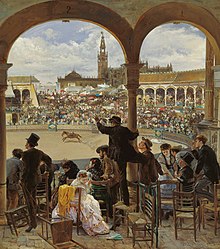
Back Costumbrismo Welsh Costumbrismo German Ĝenrismo Esperanto Costumbrismo Spanish Kostunbrismo Basque Costumbrismo French Costumismo Galician Kostumbrizam Croatian Կոստումբրիզմ Armenian Costumbrismo Italian

Costumbrismo (in Catalan: costumisme; sometimes anglicized as costumbrism, with the adjectival form costumbrist) is the literary or pictorial interpretation of local everyday life, mannerisms, and customs, primarily in the Hispanic scene, and particularly in the 19th century. Costumbrismo is related both to artistic realism and to Romanticism, sharing the Romantic interest in expression as against simple representation and the romantic and realist focus on precise representation of particular times and places, rather than of humanity in the abstract.[1][2] It is often satiric and even moralizing, but unlike mainstream realism does not usually offer or even imply any particular analysis of the society it depicts. When not satiric, its approach to quaint folkloric detail often has a romanticizing aspect.
Costumbrismo can be found in any of the visual or literary arts; by extension, the term can also be applied to certain approaches to collecting folkloric objects, as well. Originally found in short essays and later in novels, costumbrismo is often found in the zarzuelas of the 19th century, especially in the género chico. Costumbrista museums deal with folklore and local art and costumbrista festivals celebrate local customs and artisans and their work.
Although initially associated with Spain in the late 18th and 19th century, costumbrismo expanded to the Americas and set roots in the Spanish-speaking portions of the Americas, incorporating indigenous elements. Juan López Morillas summed up the appeal of costumbrismo for writing about Latin American society as follows: the costumbristas' "preoccupation with minute detail, local color, the picturesque, and their concern with matters of style is frequently no more than a subterfuge. Astonished by the contradictions observed around them, incapable of clearly understanding the tumult of the modern world, these writers sought refuge in the particular, the trivial or the ephemeral."[3]
- ^ José Escobar, Costumbrismo entre Romanticismo y Realismo, Biblioteca Virtual Miguel Cervantes. Accessed online 2010-01-22.
- ^ Antonio Reina Palazón, El Costumbrismo en la Pintura Sevillana del Siglo XIX Archived 2008-09-16 at the Wayback Machine, Biblioteca Virtual Miguel Cervantes. Accessed online 2010-01-22.
- ^ Juan López Morillas, El Krausismo español (1980), p. 129, quoted by Enrique Pupo-Walker, "The brief narrative in Spanish America 1835–1915", 490:535 in Roberto González Echevarría, Enrique Pupo-Walker, The Cambridge History of Latin American Literature: Discovery to modernism, Cambridge University Press, 1996, ISBN 0-521-34069-1. p. 491 accessed on Google Books.
© MMXXIII Rich X Search. We shall prevail. All rights reserved. Rich X Search